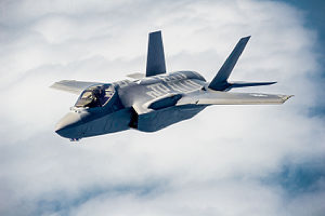Dumping on the F-35 Strategic Fighter: Trump on Defense Spending and the Military Industrial Complex

That particular fighter never had good press. Even before Lockheed Martin’s F-35 Joint Strategic Fighter attracted the ire of Donald Trump via his usual, belching medium, Twitter, the project was flailing in a swamp to the value of $400 billion.
On Monday, Trump tweeted that Lockheed’s “F-35 program and cost is out of control. Billions of dollars can and will be saved on military (and other) purchases after January 20th.” But the stock prices of the company were already falling, providing a faint whiff of insider trading. Had Trump tipped off someone about his target company?[1] (Not that he needed to – a deeper analysis would have already shown the company to be taking a hit.)
Whatever the case, the remarks stunned and burned those connected with the bloated military enterprise that is Lockheed Martin. Stocks fell. The hedge fund managers proceeded to finalise what they had already started. All in all, 4 per cent of the stock had been shed in early trade. Other military stocks also purged some value.
The President-elect was at it again, rubbishing parts of US industry (and a fine, killing industry at that) in an effort to make America great again. Bloated, wasteful, obese – this was the predicament facing a fighter that was meant to have everything going for it, a consortium driven enterprise that was meant to revolutionise future combat.
The tally board for the F-35 is poor, and has stirred some dissent. Washington’s allies have not all been pleased, despite assurances that the mammary glands of Mother Empire have been doing their trick.
Canada’s Prime Minister, Justin Trudeau, has been mixed. “I do hear that it’s not very good. I’m hearing that our existing planes are better. And one of the pilots came out of the plane, one of the test pilots, and said ‘this isn’t as good as what we already have’.”[2]
That said, Trudeau will still consider the F-35, provided it goes to an open competition. “It’s an open and transparent competition we’re going to be engaged in and the various aircraft and aircraft producers will have an opportunity to make their best case.”[3]
Other than that, Lockheed has not topped of the list of procurements by the Canadian government, which provided a notable snub in November by revealing plans to purchase 18 Boeing Corp Super Hornets as an interim measure.
Australia’s officials, characteristically confused, have managed to dig themselves into the mire of a contract that will drain more than provide. Despite reservations by some former Defence Force members at Canberra’s plans to acquire 72 F-35s, the Chief of the Royal Australian Air Force, Air Marshal Leo Davies, spoke with hoodwinked confidence in having “absolutely no reservations, zero reservations, about the decision for the Joint Strike Fighter being the Classic Hornet replacement for Australia.”[4]
In a fascinating sense, the Joint Strategic Fighter has become, not merely an economic target but a cultural one, attacked for being a product of establishment deception and conventional cronyism. Outsider Trump, not exactly squeaky clean himself, is rallying as the critic of insider rot, insisting that there be a “lifetime restriction” on high ranking Pentagon officials in working for defence contractors.
In an interview for Fox News Sunday, Trump outlined a philosophy of defence establishment cleaning. “The people that are making these deals for the government, they should never be allowed to go work for these companies.”[5]
The Pentagon, not without reason, is deemed untrustworthy with its projections, cooking the defence books and diligently covering tracks. This incentive is also assisted by the seemingly inextricable ties between defence contractors and former Pentagon employees.
The Government Accountability Office, in 2008, noted the sheer scope of these links, though it did also identify post-government employment restrictions. “In 2006, 52 contractors employed 2,435 former DOD senior acquisition officials who had previously served as generals, admirals, senior executives, program managers, contracting officers, or in other acquisition positions which made them subject to restrictions on their post-DOD employment.”[6]
Well and good – but for the fact that the GAO had to admit to “a significant under-reporting of the contractors’ employment of former DOD officials.” Employment restrictions in the private sector after life in the Pentagon, in other words, is not always a rigorously policed thing.
These particular arrangements have now been aired by the property tycoon cum president-elect, one who knows a thing or two about inventive accounting and fictitious projections. To that can be added the very definition of conflict of interest. It takes a deeply accomplished sinner to know one.
Found short on performance but long on budget, the backers of the F-35 have become prime targets for the Trump show. Jeff Babione, Lockheed Martin’s F-35 program manager, has insisted that trimming has taken place, though he has taken the back route in explaining the company strategy.
“Since the beginning, we have invested hundreds of thousands of millions of dollars to reduce the price of the airplane by about 70 per cent since it original costing”. Money must be spent in order to reduce the money that needs to be spent, a delightful example of convoluted military speak.
That sort of talk has the demagogues up in arms. They want results. Killing machines that perform and are made according to budget are desired in the name of both populism and effectiveness.
In many senses, this is the counter-intuitive nature of the Military Industrial Complex, which has historically favoured the illusion of appropriate yet extortionately expensive defence in the face of global phantom enemies. But this is the sort of administrative scuffle that may well see the shelving of one of the less glorious products in US air history.
Dr. Binoy Kampmark was a Commonwealth Scholar at Selwyn College, Cambridge. He lectures at RMIT University, Melbourne. Email: [email protected]
Notes
[1] http://fortune.com/2016/12/13/
[2] https://www.skiesmag.com/news/
[3] http://www.theglobeandmail.
[4] http://www.abc.net.au/news/
[5] https://www.washingtonpost.
[6] http://www.gao.gov/products/

